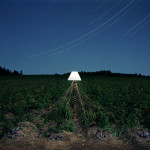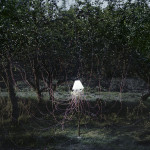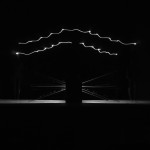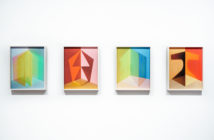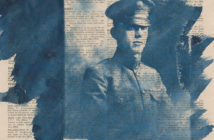We think we know how photographs are made. It’s an almost instantaneous assumption that informs our perceptions, to some degree or another, in the gallery and elsewhere. But if you can decipher Caleb Charland or Maggie Stark's processes at first blush, then you must know something the rest of us don’t. Because their practice appears to be pure magic. I spent some time atGallery Kayafas, gazing quizzically at these prints, until director Arlette and her assistant Stephanie were kind enough to divulge a few of the artists‘ secrets. It wasn’t hard to devote my full attention to this work. It’s captivating. I had first seen the entry for Caleb Charland’s Backscatter in the Flash Forward Festival catalog; or, more precisely, the accompanying photograph Attempting to Paddle Straight at the Moon had immediately caught my eye while flipping through its pages. The description registered later. Unaware of the work’s title, I found myself confronted by an abstraction that perceptually morphed into a canoe gliding across a still lake toward a luminous line in the sky, a moon transformed by a long exposure. Charland must have mounted his camera on the canoe, and his attempt to paddle straight forward had become his photographic process. His movement from side to side is captured in the moon, which serves as a measurement of the success of his endeavor. In one sense, that is. Artistically, he is off the charts.
I’ve come to expect top-notch exhibitions at Gallery Kayafas. They consistently show fresh work that is as conceptually challenging as it is visually striking. But Charland’s photographs exceeded my already high expectations. In silver screen parlance, I would put it this way: if you see only one photography exhibition this year, let it be Backscatter. Don’t get me wrong, Stark is no slouch either. Her Still/Time series accomplishes the uncanny feat of politicizing minimalist aesthetics. And both bodies of work can be credited with sharing their secrets without revealing them: the secrets of their production, meanings, identifications. Never before have I asked so frequently "What is that?" while marveling at photographs. And then, "How did they do that?" Usually, these are questions reserved for bad art, and for entirely different reasons, as you might imagine.
Charland has an eclectic, versatile style. His photographs range in size from 3.625 by 2.875 inches to 50 by 40 inches. So do his processes. Included in the exhibition are pigment, gelatin silver, contact, and Lambda C-type prints, along with gelatin silver photograms. This isn’t ordinarily done, but it works wonders in Charland’s case. And when you think about it, that makes perfect sense. His photographs are a kind of exploration into what might be called the scientific miracles all around us. Luckily for us, those miracles turn out to be artistic ones, too. Charland’s experiments include the creation of light from potatoes, apples, oranges, lemons and limes. He rigs up the fruit and vegetables to floor and desk lamps, drawing from their electricity to, as it were, power the grid. This affords Charland the opportunity to take chimerical photographs with the power to provoke wonder. Philosophy may begin in wonder, as the adage goes, but it can be one of the more elusive emotions in photography. Not so in Charland’s Potato Power, LaJoie Growers LLC, Van Buren, Maine or Apple Trees and LEDs, both long exposures of about 8 and 4 hours, respectively. The star trail in Potato Powertracks the duration, but there is very little motion blur on the ground, just enough to make the dozens of wires strung from lamp to buried potatoes seem almost vinelike. The illusion is enhanced in Apple Trees and LEDs. Wires run every which way from the lightbulb they power to apples in the branches overhead. Only the apples illuminate the leaves above and trammeled grass below.
Charland can make a thumbprint in glue appear to be as expansive, as awe-inspiring as a galaxy. He can make fingerprints resemble star clusters, and the lines in his palms look like constellations. And it’s not just that he uses his hands to symbolize the universe; rather, his images could easily be mistaken for those more ethereal realms. Charland’s photograms are as explosive as supernovae. But then, everything becomes something it’s not in these images. Handheld mirrors are a "study for sun," but look more like silver moons to my eye. Matches become meteor showers burning up in the atmosphere, or is it shooting stars? Cigarette lighters are, possibly, the surface of a star, a "light sphere"? Interpretations will vary, but there is no doubt that these most ordinary of objects assume celestial significance.
Just look up "backscatter" or "Fibonacci," if you’re not already familiar with the words, and you’ll have a better sense of Charland’s angle. And it will help you interpret his formalist piece Fibonacci’s Pendulum, which strikes a somewhat different chord than his other photographs. Or find his star fields in the gallery, images Charland has downloaded online (you can see the pixellation) and made his own unique creations by moving water across their surfaces to form nebulae. If you’re not curious yet, you will be when you see Charland’s photographs.
And since your curiosity will already be piqued, you’re in luck. Maggie Stark’s Still/Time will give your imagination a run for its money. Stark works in video, sculpture, and, of course, photography. Her photos on view at Gallery Kayafas are stills from Wall/Play and Still/Time, her exhibition’s namesake. As images, they are minimal, sparse, and conceptual. And in the absence of further information, I was hard pressed to decipher their lines and dots. But Stephanie was right that Stark’s videos are the key to unlocking their meaning (so be sure to watch those first), and some background knowledge is helpful, too.
Stark was living in Berlin for the 20th anniversary of the fall of the Berlin wall, and her experiences there have everything to do with the conceptual framework for Still/Time. These are games to be played by those on opposite sides, literally and figuratively: seesaw and hopscotch, which I mistook for Lite-Brite. Stark constructed the seesaw sculpture herself, a pared down model of which is on view at Gallery Kayafas. Lined with mirrors, excepting the sids of the beams facing us, it reflects whatever light is available. But as Stark’s models are dressed in black body suits, and play in the dark, that’s not much. Instead, they wear helmets with lights, the kind coal miners might. Their movement up and down on the seesaw illuminates the mirrors, throwing light outward, but leaves the dark wall of the central beam facing us in shadow. It’s about division, but also reciprocity, the necessity of working together, wall and play. This theme is picked up in her hopscotch video. We see the same figures in body suits, this time at opposite ends of a grid of lightbulbs. Their actions must be symmetrical. Those are the rules of the game. When one player screws in or unscrews a lightbulb on one side, so must the other on the opposite side. We watch these two as they change patterns, recreate and transform the grid, create walls of light and take them apart. Eventually, they must both reach for the same bulb.
This might all seem quite far from the Berlin wall (it did to me), but the idea of competitors who must work together is ever present, and sometimes the metaphorical wall is, too. Two opposing sides share an electrical grid. When one is up, the other is down, and so it goes. They compete, but are ever linked by their game, each dependent on the other. Even in 2013, the divide between East and West Berlin is visible from space in the differential coloring of the distinct types of lightbulbs that predominate on either side. But as this is conceptual art, it’s the idea of "/" rather than the history, culture, or politics of East and West Germany that motivates it. And that, ultimately, is how you must frame your interpretation. There’s something interesting, and seemingly contradictory, in creating minimalist abstractions out of human bodies and their actions. And the ideas that Stark explores in her work are, after all, inherently political ones (and her inspiration, of course, could not be more political). Is this political minimalism, then? As an appreciator of the conceptual twist that can be given to old ideas that makes them shiny and new, I take pleasure in this thought. Great art, art that stimulates the mind, can contradict itself. To understand it fully, we must first allow that it contains multitudes.
Charland / Stark will be on view at Gallery Kayafas through June 22. So there’s still time to pay a visit. And if you’d like to meet the artists themselves, then stop by June 7, this coming First Friday, when both will be in attendance. Only they know all of the secrets to their art. Here’s hoping they will share a few.
- Fibonacci’s Pendulum 2011 #1/3 40×32″ pigment print ©Caleb Charland
- Potato Power, LaJoie Growers LLC, Van Buren, Maine 2012 #1/5 23×29″ Pigment print ©Caleb Charland
- Apple Trees and LEDs 2011 #1/3 32×40″ pigment print ©Caleb Charland
- Untitled #2 (time lapse still from Still/Time video) 30×22″ archival inkjet print ©Maggie Stark
- Sides: 9 On (Wall Play series #6) 12×30″ archival screen-printed aluminum print ©Maggie Stark





